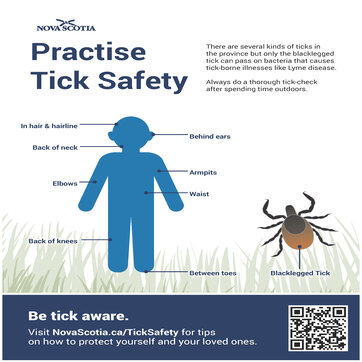Enjoy the outdoors and be tick aware!
Summer and fall in Nova Scotia are wonderful seasons where people spend countless hours outdoors at the many beautiful beaches, trails, parks, and wooded areas across our province. As we take in these natural riches, we should also be mindful of the presence of ticks.
Here are some steps that you can take to protect yourself and your loved ones, especially in grassy, wooded, or shrub-covered areas:
- Apply insect repellents containing DEET or Icaridin to exposed skin and clothes. Follow directions on the package carefully. Infants under the age of six months should not use these products. Please visit Personal Insect Repellents - Canada.ca for specific instructions.
- Wear light colored, long-sleeved shirts and pants, closed-toed shoes, and tuck shirts into pants and pant legs into socks.
- Keep lawns mowed short.
- Put playground equipment in sunny, dry places away from wooded areas, yard edges, and trees.
- Check your whole body for ticks when possible (especially armpits, ears, knees, hair, groin) and take a bath or shower within two hours of coming indoors. This makes it easier to find ticks and washes away loose ones.
- Clothing is available that is treated with Permethrin (a chemical repellent) and can protect against ticks and mosquitoes for those 16 years of age and older. This clothing is not approved for those under 16 years of age in Canada.
What do I do if I find a tick on me/my child?
If you find a tick on your body, remove it as soon as possible to lessen the risks of infection. Here’s how to remove them safely:
- Carefully grasp the tick with tweezers as close to the skin as possible.
- Gently and slowly pull the tick straight out. Don’t jerk, twist or squeeze it.
- Clean and disinfect the site with soap and water, rubbing alcohol or hydrogen peroxide.
- To dispose of a tick, place it in a sealed plastic bag and either drown it in rubbing alcohol or freeze it for several days. Don’t crush ticks with exposed fingers. Once dead, throw the bagged tick in the garbage.
- Do NOT burn, squeeze, or coax a tick’s mouthparts from your skin using other methods.
How to keep your pets safe
While dogs and cats cannot directly transmit Lyme disease to people, a tick may enter your home on your pet's back and move on to bite a human. It is important to follow precautions for them too!
- Use veterinarian-recommended tick and flea preventatives for dogs and cats, especially during peak tick season (spring through fall). Not all products are safe for all species or ages—consult your vet for the most appropriate option.
- Check your pets for ticks daily after they’ve been outdoors—especially around the ears, neck, under the collar, and between the toes.
- Avoid letting pets roam through tall grasses or wooded areas where ticks are more likely to be found.
- Keep pet resting areas clean and inspect pet bedding regularly, especially if they spend time outdoors.
Download the new eTick application for free.
eTick.ca is a free service that can identify the type of tick usually within 24 hours. Though Lyme and other tick-borne diseases in Nova Scotia are transmitted by the blacklegged (deer) tick, not all black-legged ticks carry disease and not all blacklegged ticks have black legs.
For more information on tick-borne diseases, please visit: https://novascotia.ca/DHW/CDPC/lyme.asp
pdf To view the letter from Dr. Ryan Sommers of the Nova Scotia Health, click here.(123 KB)



